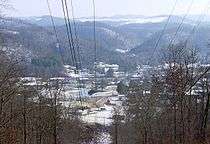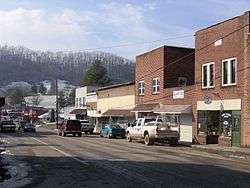Sneedville, Tennessee
| Sneedville, Tennessee | |
|---|---|
| Town | |
|
Main Street (TN-33) in Sneedville | |
|
Location of Sneedville, Tennessee | |
| Coordinates: 36°31′55″N 83°12′51″W / 36.53194°N 83.21417°WCoordinates: 36°31′55″N 83°12′51″W / 36.53194°N 83.21417°W | |
| Country | United States |
| State | Tennessee |
| County | Hancock |
| Settled | 1790s |
| Incorporated | 1850[1] |
| Named for | William Henry Sneed |
| Area | |
| • Total | 2.3 sq mi (5.9 km2) |
| • Land | 2.3 sq mi (5.9 km2) |
| • Water | 0.0 sq mi (0.0 km2) |
| Elevation | 1,171 ft (357 m) |
| Population (2010) | |
| • Total | 1,387 |
| • Density | 600/sq mi (240/km2) |
| Time zone | Eastern (EST) (UTC-5) |
| • Summer (DST) | EDT (UTC-4) |
| ZIP code | 37869 |
| Area code(s) | 423 |
| FIPS code | 47-69460[2] |
| GNIS feature ID | 1303706[3] |
Sneedville is a town in Hancock County, Tennessee, United States. The population was 1,387 at the 2010 census. It is the county seat of Hancock County.[4]
History
European-American settlement began in the 1790s,[5] as migrants moved into the area from the Piedmont frontiers of Virginia and North Carolina. Such migrants had formed families in colonial Virginia. Among them was a multi-racial group of settlers who became known as Melungeon. They have been documented as having primarily European and sub-Saharan African, with a lesser amount of Native American ancestry.
The county historical society asserts that French traders noted encountering the Melungeons in the late 1600s in the area that is now east Tennessee.[6] Such early settlement is not supported by the work of Edward Price, a cultural geographer, who wrote a 1950 dissertation on the Melungeons;[7] Dr. Virginia DeMarce, a professional genealogist;[8] and Paul Heinegg, a genealogist,[9] who have documented the migration of ancestors of the first families known as Melungeon from Virginia and North Carolina in the late eighteenth century.
Sneedville was originally known as "Greasy Rock." When Hancock County was formed from parts of Hawkins and Claiborne counties in the 1840s, Greasy Rock was chosen as the county seat. The town was renamed in honor of William Henry Sneed (1812–1869), an attorney from Knoxville who helped defend the new county when several residents sued in an attempt to block its creation.[10]
Geography
Sneedville is located at 36°31′55″N 83°12′51″W / 36.53194°N 83.21417°W (36.532062, -83.214140).[11]
According to the United States Census Bureau, the town has a total area of 2.3 square miles (6.0 km2), all land. The Clinch River passes within the city limits.
Demographics
| Historical population | |||
|---|---|---|---|
| Census | Pop. | %± | |
| 1870 | 177 | — | |
| 1880 | 157 | −11.3% | |
| 1890 | 156 | −0.6% | |
| 1960 | 799 | — | |
| 1970 | 874 | 9.4% | |
| 1980 | 1,110 | 27.0% | |
| 1990 | 1,446 | 30.3% | |
| 2000 | 1,257 | −13.1% | |
| 2010 | 1,387 | 10.3% | |
| Est. 2015 | 1,346 | [12] | −3.0% |
| Sources:[13][14] | |||
As of the 2010 United States Census, there were 1,387 people residing in the town. 97.4% were White, 0.6% Black or African American, 0.3% Native American, 0.1% Asian and 1.7% of two or more races. 0.3% were Hispanic or Latino (of any race).
As of the census[2] of 2000, there were 1,257 people, 527 households, and 310 families residing in the town. The population density was 551.0 people per square mile (212.9/km²). There were 593 housing units at an average density of 259.9 per square mile (100.4/km²). The racial makeup of the town was 97.69% White, 0.64% African American, 0.16% Native American, 0.72% from other races, and 0.80% from two or more races. Hispanic or Latino of any race were 0.24% of the population. Melungeons, a so-called "tri-racial isolate", are also present in this area, especially in the Vardy Valley, on the other side of Newman's Ridge.

There were 527 households out of which 27.1% had children under the age of 18 living with them, 41.2% were married couples living together, 14.6% had a female householder with no husband present, and 41.0% were non-families. 38.9% of all households were made up of individuals and 18.6% had someone living alone who was 65 years of age or older. The average household size was 2.08 and the average family size was 2.77.
In the town the population was spread out with 18.4% under the age of 18, 11.4% from 18 to 24, 28.2% from 25 to 44, 23.5% from 45 to 64, and 18.5% who were 65 years of age or older. The median age was 40 years. For every 100 females there were 93.7 males. For every 100 females age 18 and over, there were 96.9 males.
The median income for a household in the town was $13,281, and the median income for a family was $20,208. Males had a median income of $20,500 versus $15,461 for females. The per capita income for the town was $13,173. About 32.9% of families and 36.3% of the population were below the poverty line, including 46.9% of those under age 18 and 28.4% of those age 65 or over.
In 2010, Sneedville had the 10th-lowest median household income of all places in the United States with a population over 1,000.[15]
Arts and culture
Annual cultural events
Sneedville hosts two major festivals yearly, the Jimmy Martin Memorial Bluegrass festival in May,[16] and the annual Hancock County Fall Festival on the first weekend of October. This festival highlights some of the most prominent cultural features of the area with music, crafts, and food.
Museums and related points of interest
The Hancock County Tennessee Historical and Genealogical Society is a non-profit organization located in the Old County Jail. The organization provides access to archival material related to the community, and maintains a small museum displaying aspects of traditional mountain life. They publish a bi-yearly newsletter called Our Mountain Heritage for members of the society.[17]
Education
Schools in Sneedville include Hancock County Middle/High School and Hancock County Elementary School.
Infrastructure
Hancock County Hospital, which opened in 2005, is located in Sneedville.[18]
Notable people
- Doyle Lawson, a musician, lived in Sneedville as a child.[19]
- Jimmy Martin, a musician, was born in Sneedville. He was dubbed "King of Bluegrass" and inducted into the International Bluegrass Music Hall of Honor.[20]
See also
Further reading
- Hancock County Tennessee and It’s People, Volume I, II & III. Sneedsville: Hancock County Historical & Genealogical Society.
- Hancock County Tennessee Pictorial History Book. Sneedsville: Hancock County Historical & Genealogical Society.
References
- ↑ Tennessee Blue Book, 2005-2006, pp. 618-625.
- 1 2 "American FactFinder". United States Census Bureau. Retrieved 2008-01-31.
- ↑ "US Board on Geographic Names". United States Geological Survey. 2007-10-25. Retrieved 2008-01-31.
- ↑ "Find a County". National Association of Counties. Retrieved 2011-06-07.
- ↑ Will Thomas Hale and Dixon L. Merritt, A History of Tennessee and Tennesseans, Vol. 3 (Lewis Publishing Co., 1913), p. 794.
- ↑ "Historical Hancock County". Home. Hancock County Tennessee Historical and Genealogical Society. 2008. Retrieved 13 November 2011.
- ↑ Price, Edward T. (1953). "A Geographic Analysis of White-Negro-Indian Racial Mixtures in Eastern United States", Annals of the Association of American Geographers 43 (June 1953): 138–155, accessed 18 February 2013
- ↑ DeMarce, Virginia E. (1992). "'Verry Slitly Mixt': Tri-Racial Isolate Families of the Upper South – A Genealogical Study", National Genealogical Society Quarterly 80 (March 1992): 5–35, scanned online, Historical-Melungeons, accessed 18 February 2013
- ↑ Paul Heinegg, Free African Americans in Virginia, North Carolina, South Carolina, Delaware and Maryland, 1999–2005
- ↑ William G. Cook, "Hancock County," Tennessee Encyclopedia of History and Culture. Retrieved: 18 February 2013.
- ↑ "US Gazetteer files: 2010, 2000, and 1990". United States Census Bureau. 2011-02-12. Retrieved 2011-04-23.
- ↑ "Annual Estimates of the Resident Population for Incorporated Places: April 1, 2010 to July 1, 2015". Retrieved July 2, 2016.
- ↑ "Census of Population and Housing: Decennial Censuses". United States Census Bureau. Retrieved 2012-03-04.
- ↑ "Incorporated Places and Minor Civil Divisions Datasets: Subcounty Resident Population Estimates: April 1, 2010 to July 1, 2012". Population Estimates. U.S. Census Bureau. Retrieved 11 December 2013.
- ↑ "US Census". Retrieved 18 January 2014.
- ↑ "Jimmy Martin Memorial Bluegrass Festival". Home. Hancock County Tennessee Historical and Genealogical Society. 2007. Retrieved 13 November 2011.
- ↑ "Hancock County Tennessee Historical and Genealogical Society". Home. Hancock County Tennessee Historical and Genealogical Society. 2008. Retrieved 13 November 2011.
- ↑ "Hancock County Hospital". Hancock County Hospital. Wellmont Health System. 2011. Retrieved 13 November 2011.
- ↑ "Doyle Lawson & Quicksilver". Artists. Decca Records. 2010. Retrieved 13 November 2011.
- ↑ "Jimmy Martin". Bluegrass Masters. International Bluegrass Music Hall of Honor. 2011. Retrieved 13 November 2011.
